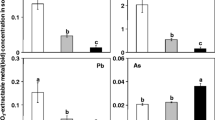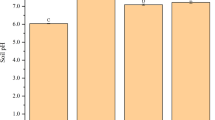Abstract
Potential human health risk with agricultural food consumption grown in heavy metal–contaminated soil has rarely been investigated. A field experiment was conducted to investigate the effect of rice straw biochar and bamboo biochar on Cd/Cu phytoavailability, stabilization, and human health risk with crop consumption grown in contaminated soil. In this study, rice straw biochar and bamboo biochar were applied to contaminated soil (at the rate of 1.125 × 104 and 2.25 × 104 kg·ha−1) to suppress Cd/Cu bioavailability and thereby mitigating their accumulation in rice, rape, and corn. The results showed that biochar application had significantly reduced DTPA extractable Cd/Cu content in contaminated soil, especially the high dosage addition. Biochar application considerably influenced chemical fraction of Cd/Cu, which was notably increased in residual fraction and decreased in exchangeable fraction of Cd/Cu in biochar-amended soil. Compared to the control treatment, biochar application had significantly reduced Cd/Cu concentration in rice, corn, and rape seed, respectively. Hazard quotients (HQ) associated with rice, corn, and rape consumption were significantly reduced in biochar-amended soil. Consequentially, human cancer risk (HCR) value for Cd associated with rice consumption was significantly reduced by 27.70% with bamboo biochar (at the rate of 2.25 × 104 kg·ha−1) treatment. The possible mechanisms in reducing HQ and HCR were due to biochar efficiency to decrease bioavailable Cd, promote the Cd immobilization, and suppress the crop uptake. In conclusion, these results highlighted the potential for biochar to mitigate the phytoavailability and accumulation of heavy metals and thereby reducing heavy metals exposure associated with rice consumption. Thus, biochar is a promising eco-friendly material to be used to diminish HQ and HCR in soil crop system.





Similar content being viewed by others
Data Availability
The dataset used and/or analyzed in this study are available from the corresponding author on reasonable request.
References
Abbas, T., Rizwan, M., Ali, S., Zia-ur-Rehman, M., Qayyum, M. F., Abbas, F., Hannan, F., Rinklebe, J., & Ok, Y. S. (2017). Effect of biochar on cadmium bioavailability and uptake in wheat (Triticum aestivum L.) grown in a soil with aged contamination. Ecotoxicology and Environmental Safety., 140, 37–47.
Ahmad, M., Usman, A. R. A., Al-Faraj, A. S., Ahmad, M., Sallam, A., & Al-Wabel, M. I. (2018). Phosphorus-loaded biochar changes soil heavy metals availability and uptake potential of maize (Zea mays L.) plants. Chemosphere, 194, 327–339.
Bian, R. J., Chen, D., Liu, X. Y., Cui, L. Q., Li, L. Q., Pan, G. X., et al. (2013). Biochar soil amendment as a solution to prevent Cd-tainted rice from China: Results from a cross-site field experiment. Ecological Engineering, 58, 378–383.
Chen, D., Guo, H., Li, R. Y., Li, L. Q., Pan, G. X., Chang, A., & Joseph, S. (2016). Low uptake affinity cultivars with biochar to tackle Cd-tainted rice - A field study over four rice seasons in Hunan. China. Sci. Total Environ., 541, 1489–1498.
Cui, L. Q., Pan, G. X., Li, L. Q., Bian, R. J., Liu, X. Y., Yan, J. L., et al. (2016). Continuous immobilization of cadmium and lead in biochar amended contaminated paddy soil: A five-year field experiment. Ecological Engineering, 93, 1–8.
Dong, X., Ma, L. Q., & Li, Y. (2011). Characteristics and mechanisms of hexavalent chromium removal by biochar from sugar beet tailing. Journal of Hazardous Materials, 190(1–3), 909–915.
GB 2762. (2017). National food safety standard limit of contaminants in food (in Chinese).
Inaba, T., Kobayashi, E., Suwazono, Y., et al. (2005). Estimation of cumulative cadmium intake causing Itai-itai disease. Toxicology Letters, 159, 192–201.
Jarup, L. (2003). Hazards of heavy metal contamination. British Medical Bulletin, 68, 167–182.
Jiang, J., Xu, R. K., Jiang, T. Y., & Li, Z. (2012). Immobilization of Cu(II), Pb(II) and Cd(II) by the addition of rice straw derived biochar to a simulated polluted Ultisol. Journal of Hazardous Materials, 229, 145–150.
Kamran, M., Malik, Z., Parveen, A., Zong, Y. T, Abbasi, G., Rafiq, M. T., Shaaban, M., Mustafa, A., Bashir, S., Rafay, M., Mehmood, S., & Ali, M. (2019). Biochar alleviates Cd phytotoxicity by minimizing bioavailability and oxidative stress in pak choi (Brassica chinensis L.) cultivated in Cd-polluted soil. Journal of Environmental Management, 250, 109500.
Khan, S., Cao, Q., Zheng, Y. M., Huang, Y. Z., & Zhu, Y. G. (2008). Health risks of heavy metals in contaminated soils and food crops irrigated with wastewater in Beijing China. Environmental Pollution, 152, 686–692.
Khan, S., Reid, B. J., Li, G., & Zhu, Y. G. (2014). Application of biochar to soil reduces cancer risk via rice consumption: A case study in Miaoqian village, Longyan, China. Environment International, 68, 154–161.
Khan, A. Z., Ding, X., Khan, S., Ayaz, T., Fidel, R., & Khan, M. A. (2020). Biochar efficacy for reducing heavy metals uptake by Cilantro (Coriandrum sativum) and spinach (Spinaccia oleracea) to minimize human health risk. Chemosphere, 244, 125543.
Kim, S. C., Kim, H. S., Seo, B. H., Owens, G., & Kim, K. R. (2015). Phytoavailability control based management for paddy soil contaminated with Cd and Pb: Implications for safer rice production. Geoderma, 270, 83–88.
Li, G., Sun, G. X., Williams, P. N., Nunes, L., & Zhu, Y.-G. (2011). Inorganic arsenic in Chinese food and its cancer risk. Environment International, 37, 1219–1225.
Li, H. Y., Ye, X. X., Geng, Z. G., Zhou, H. J., Guo, X. S., Zhang, Y. X., et al. (2016). The influence of biochar type on long-term stabilization for Cd and Cu in contaminated paddy soils. Journal of Hazardous Materials, 304:40–8.
Li, H., Dong, X., da Silva, E. B., de Oliveira, L. M., Chen, Y., & Ma, L. Q. (2017). Mechanisms of metal sorption by biochars: biochar characteristics and modifications. Chemosphere, 178, 466–478.
Liu, X., Gu, S., Yang, S., Deng, J., & Xu, J. (2021). Heavy metals in soil-vegetable system around E-waste site and the health risk assessment. Science of the Total Environment, 779, 146438.
Lu, S. G., & Zong, Y. T. (2018). Pore structure and environmental serves of biochars derived from different feedstocks and pyrolysis conditions. Environmental Science and Pollution Research, 25(30), 30401–30409.
Lu, K. P., Yang, X., Gielen, G., Bolan, N., Ok, Y. S., Niazi, N. K., et al. (2017). Effect of bamboo and rice straw biochars on the mobility and redistribution of heavy metals (Cd, Cu, Pb and Zn) in contaminated soil. Journal of Environmental Management, 186, 285–292.
Lucchini, P., Quilliam, R. S., DeLuca, T. H., Vamerali, T., & Jones, D. L. (2014). Does biochar application alter heavy metal dynamics in agricultural soil? Agriculture, Ecosystems & Environment, 184, 149–157.
Meng, L., Huang, T. H., Shi, J. C., Chen, J., Zhong, F. L., Wu, L. S., & Xu, J. M. (2019). Decreasing cadmium uptake of rice (Oryza sativa L.) in the cadmium-contaminated paddy field through different cultivars coupling with appropriate soil amendments. Journal of Soils and Sediments, 19(4):1788–98.
Munir, M. A. M., Liu, G. J., Yousaf, B., Mian, M. M., Ali, M. U., Ahmed, R., Cheema, A. I., & Naushad, M. (2020). Contrasting effects of biochar and hydrothermally treated coal gangue on leachability, bioavailability, speciation and accumulation of heavy metals by rapeseed in copper mine tailings. Ecotoxicology and Environmental Safety, 191.
Nakagawa, H., Tabata, M., Morikawa, Y., et al. (1990). High mortality and shortened lifespan in patients with itai-itai disease and subjects with suspected disease. Arc Environmental Health, 45, 283–287.
Nie, C., Yang, X., Niazi, N., Xu, X., Wen, Y., Rinklebe, J., Ok, Y. S., Xu, S., & Wang, H. (2018). Impact of sugarcane bagasse-derived biochar on heavy metal availability and microbial activity: A field study. Chemosphere, 200, 274–282.
Park, J. H., Choppala, G. K., Bolan, N. S., Chung, J. W., & Chuasavathi, T. (2011). Biochar reduces the bioavailability and phytotoxicity of heavy metals. Plant and Soil, 348(1), 439.
Qi, F., Kuppusamy, S., Naidu, R., Bolan, N., Ok, Y. S., Lamb, D., Li, Y., Yu, L., Semple, K., & Wang, H. (2017). Pyrogenic carbon and its role in contaminant immobilization in soils. Critical Reviews in Environmental Science and Technology, 47, 795–876.
Ran, J., Wang, D., Wang, C., Zhang, G., & Zhang, H. (2016). Heavy metal contents, distribution, and prediction in a regional soil-wheat system. Science of the Total Environment, 544, 422–431.
Satarug, S., & Moore, M. (2004). Adverse health effect of chronic exposure to low-level cadmium in foodstuffs and cigarette smoke. Environmental Health Perspectives, 112, 1099–1103.
USEPA (United States Environmental Protection Agency). (2010). Toxicological review of inorganic arsenic. Draft Document. EPA/635/R-10/001. USEPA, Washington, DC, USA, p. 575.
Wang, Y., & Liu, R. H. (2017). Comparison of characteristics of twenty-one types of biochar and their ability to remove multi-heavy metals and methylene blue in solution. Fuel Processing Technology, 160, 55–63.
WHO (Word Health Organization). (2019). Exposure to cadmium: A major public health concern (2019 revision). https://apps.who.int/iris/bitstream/handle/10665/329480/WHO-CED-PHE-EPE-19.4.3-eng.pdf?ua=1.
Xu, C. Y., Hosseini-Bai, S., Hao, Y., Rachaputi, R. C. N., Wang, H., Xu, Z., & Wallace, H. (2015). Effect of biochar amendment on yield and photosynthesis of peanut on two types of soils. Environmental Science and Pollution Research, 22(8), 6112–6125.
Xu, P., Sun, C. X., Ye, X. Z., Xiao, W. D., Zhang, Q., & Wang, Q. (2016). The effect of biochar and crop straws on heavy metal bioavailability and plant accumulation in a Cd and Pb polluted soil. Ecotoxicology and Environmental Safety, 132, 94–100.
Yang, C. D., & Lu, S. G. (2021). Effects of five different biochars on aggregation, water retention and mechanical properties of paddy soil: A field experiment of three-season crops. Soil & Tillage Research, 205, 104798.
Yin, D. X., Wang, X., Peng, B., Tan, C. Y., & Ma, L. Q. (2017). Effect of biochar and Fe-biochar on Cd and As mobility and transfer in soil-rice system. Chemosphere, 186, 928–937.
Zhang, R. H., Li, Z. G., Liu, X. D., Wang, B. C., Zhou, G. L., Huang, X. X., Lin, C. F., Wang, A. H., & Brooks, M. (2017). Immobilization and bioavailability of heavy metals in greenhouse soils amended with rice straw-derived biochar. Ecological Engineering, 98, 183–188.
Zheng, R., Chen, Z., Cai, C., Tie, B., Liu, X., Reid, B., et al. (2015). Mitigating heavy metal accumulation into rice (Oryza sativa L.) using biochar amendment - A field experiment in Hunan. China. Environ. Sci. Pollut. Res., 22, 11097–11108.
Zong, Y. T., Xiao, Q., & Lu, S. G. (2016). Acidity, water retention, and mechanical physical quality of a strongly acidic Ultisol amended with biochars derived from different feedstocks. Journal of Soils and Sediments, 16(1), 177–190.
Zong, Y. T., Xiao, Q., & Lu, S. G. (2021a). Biochar derived from cadmium-contaminated rice straw at various pyrolysis temperatures: Cadmium immobilization mechanisms and environmental implication. Bioresource Technology, 321, 124459.
Zong, Y. T., Xiao, Q., Malik, Z., Su, Y., Wang, Y. F., & Lu, S. G. (2021b). Crop straw-derived biochar alleviated cadmium and copper phytotoxicity by reducing bioavailability and accumulation in a field experiment of rice-rape-corn rotation system. Chemosphere, 280, 130830.
Funding
This research was supported by National Key R & D Program of China (2016YFD0800401), the National Natural Science Foundation of China (41907066), and the Postdoctoral Science Foundation of China (2018M630681).
Author information
Authors and Affiliations
Contributions
Yutong Zong: conceptualization, investigation, methodology, data curation, and writing—original draft, review, and editing. Qing Xiao: investigation, methodology, date curation, and writing—original draft. Zaffar Malik: review. Shenggao Lu: conceptualization, project administration, supervision, funding acquisition, and writing—review and editing.
Corresponding author
Ethics declarations
Ethics Approval
Not applicable.
Consent to Participate
Not applicable.
Consent for Publication
Not applicable.
Competing Interests
The authors declare no competing interests.
Additional information
Publisher's Note
Springer Nature remains neutral with regard to jurisdictional claims in published maps and institutional affiliations.
Rights and permissions
Springer Nature or its licensor (e.g. a society or other partner) holds exclusive rights to this article under a publishing agreement with the author(s) or other rightsholder(s); author self-archiving of the accepted manuscript version of this article is solely governed by the terms of such publishing agreement and applicable law.
About this article
Cite this article
Zong, Y., Xiao, Q., Malik, Z. et al. Effect of Rice Straw- and Bamboo-Derived Biochar on Pollution Controlling and Health Risks of Heavy Metals in a Rice-Rape-Corn Rotation Area of Eastern China. Water Air Soil Pollut 233, 496 (2022). https://doi.org/10.1007/s11270-022-05957-3
Received:
Accepted:
Published:
DOI: https://doi.org/10.1007/s11270-022-05957-3




